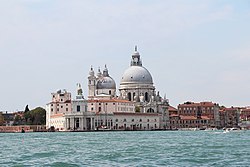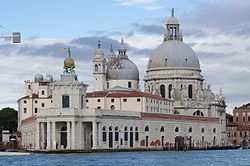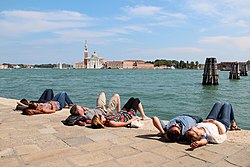The museum's art is housed in and around the Dogana da Mar building. It was built between 1678 and 1682 as a customs house [2] by Giuseppe Benoni. The arcade styles reflect their construction in different eras. [3] Atop the building are two statues of Atlas holding a golden globe upon which the figure of Fortune stands. The 17th-century statue turns in the wind. [3] The group was built by Bernardo Falconi [4] to represent the supremacy of the Republic of Venice. [2] The last renovation of the building was done by Alvise Pigazzi in 1838. [3]
Restoration
The building was restored by Tadao Ando from January 2008 to March 2009, funded by François Pinault, [5] a French billionaire and art collector. [2] He signed a 33-year agreement with the city. [6] The building had been empty for decades prior, with failed plans to turn it into apartments or a hotel. Dogana da Mar's stuccoed brick exterior was restored without additions, and is the only part of the original structure left intact. Cosmetic imperfections and the stucco were repaired, and bad areas were reinforced with stainless steel anchors, but areas with visible brick were left exposed. The interiors were left bare without surface treatment, and bricks were replaced sparingly. The room partitions from the last two centuries were replaced with parallel, rectangular halls. The roof was replaced by a similar roof with timber gables, with added skylights. The new floors are made of exposed and polished concrete, in some places covered with linoleum. [2] Frank Peter Jäger called these smooth surfaces Ando's trademark, along with glass and steel fixtures that clash with the raw irregularities of the unfinished walls. He added that, for Ando, this combination "symbolizes the union of past, present, and future", the building, his architecture, and the art within it, respectively. [2] Ando wanted to make the western entrance's face out of concrete slabs, but the change was opposed by the city. [2] Exibart's Jacqueline Ceresoli described the building as having "industrial and minimalist soul" with red brick walls. [5] The renovation cost was € 20,000,000. [2]
View of Punta della Dogana and Canal Grande from the Bacino di San Marco.
View of Punta della Dogana from the Bacino di San Marco.
View of Punta della Dogana, facing northwest.
Close-up of tip of Punta della Dogana, where Dogana da Mar, the Grand Canale, and the Giudecca Canal touch..
Entrance of museum.
Inside of Punta della Dogana after renovation.
View of San Marco from the Punta della Dogana.
View of San Giorgio Maggiore from the Punta della Dogana.
Sculpture atop the Dogana building.
Punta Della Dogana seen from San Giorgio Maggiore Island.












